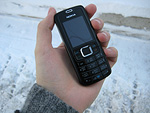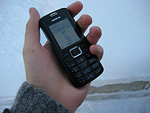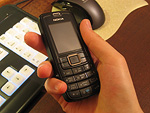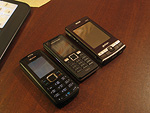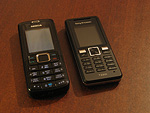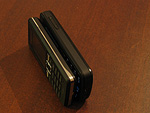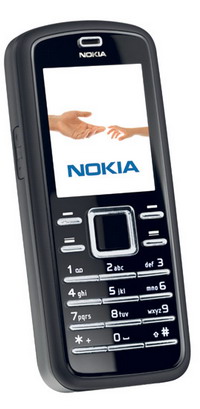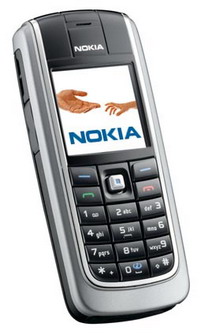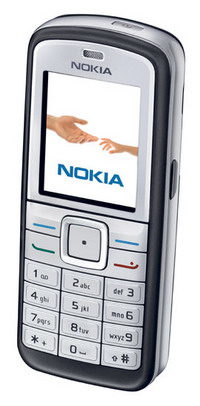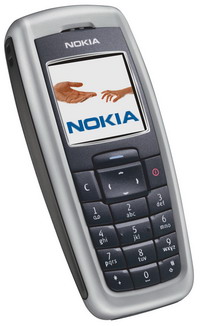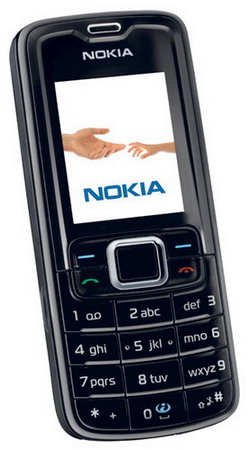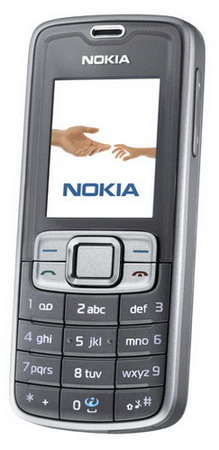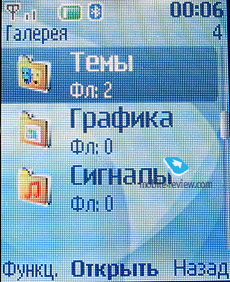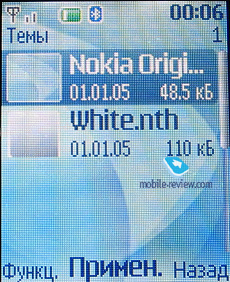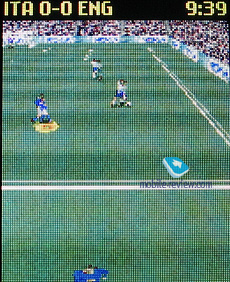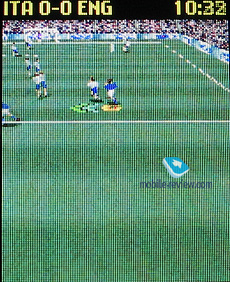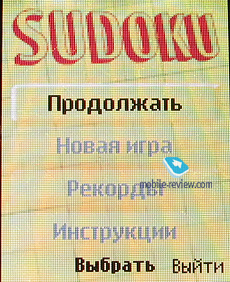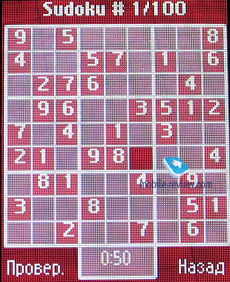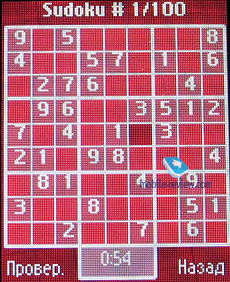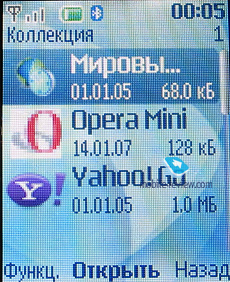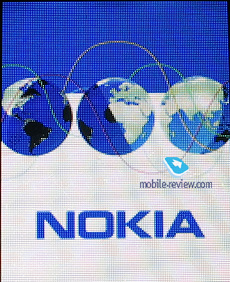Review of GSM-handsets Nokia 3109/3110 Classic
Live photos of the Nokia 3110 Classic
Table of contents:
- Positioning
- Design, size, controls
- Keypad
- Display
- Battery
- Memory, memory cards
- Performance
- USB, Bluetooth
- Camera
- Menu
- Themes, applications, games
- Competition
- Nokia 3109 as a secondary phone
- Impressions
Sales package:
- Handset
- 1020 mAh battery (BL-5C)
- Charger (AC-3)
- User Guide
- Wired mono-headset (HS-40)
Positioning
Despite the fact that Nokia keeps inflating its range with every passing year, occasionally adding even some whole new line-ups to it and foraying into new niches, the company has always had a dozen of no-frills solutions in stock. These are mid-range handsets, which are not really entry-level, since they retail for more, but they still pack pretty modest feature sets that cannot attract the youth. These are the offerings that have come along against the market’s mainstream – basically, there are here only for making calls. They can’t take stellar snaps or play crystal clear tunes or blow you away with gaming experience – no-nonsense phones, that’s it.
The market has seen a couple of different models so far – some of them were different index-wise, and obviously they all carried modified suites of features. Back in 2004 the company offered the Nokia 6610 and the Nokia 2600 for this niche, in 2005 – the 6020 and the 6021, a year ago – the Nokia 6070 and, to a lesser extent, the 6080. All these models offered reasonably mediocre entry-level esque feature packs, yet acted in the mid price bracket and offered no merits other than their calling features.
Furthermore, the Nokia 3110 that debuted back in 1997 can also be considered as the member of this club. And in 2007 this segment of Nokia-branded phones is represented by the Nokia 3109 and the 3110 Classic, positioned for the mid price bracket, coming in with pretty much unsophisticated feature sets and aimed mainly at the people preferring to use their phones in the original vein.
In this write-up we will be examining the senior model – the Nokia 3110 Classic, as there are only few things setting it apart from the 3109 Classic: color options, missing camera and FM-radio modules in the latter. As for the rest, these two handsets are totally identical.
Back to the table of contents >>>
Design, size, controls
The handset measures 108.5x46x15 mm and weights 86 grams – while it is quite pocket-friendly, we find its profile to be a little on the fat side. Nevertheless, it will readily slip into your trousers, shirt or bag.

The Nokia 3110 Classic comes only in black with the earpiece and the navigation key framing clad in chrome-like plastic. The Nokia 3109 Classic’s casing is all grey.

The front fascia of the phone is made of glossy plastic, which is, obviously, prone to smudges and grease. The display, as well as the keypad cluster will pick up your fingerprints with ease too. And being so easy to soil, the 3110 Classic can’t stay in its pristine conditions for too long – you are down to wipe it clean on a regular basis or put up with its face being all dirty and muddy.
The spines sport soft-touch inserts, the same material is employed for the entire underside, except for the area housing the camera lens and the loudspeaker. The bad thing about the soft-touch finish is that this type of surface makes all scuffs and scratches very easy to spot.
The 3110 Classic’s plastic quality was never an issue – even the glossy front does a good job in this sense. Over our three-month long quality time with the phone, it went through all abuse of our change-filled pockets and stuffed bags with flying colors.
The left-hand side houses the IrDA window, but that’s pretty much about it – no other controls or sockets are placed on the left.

Sitting on the lower edge is the charger slot (2mm), microphone, audio jack (2,5 ,,) and the flap-covered miniUSB connector. The flap is linked up to the casing, so it will be impossible to lose it somewhere.

Housed on the upper end of the 3110 Classic is a huge power button (tap and hold it to turn the device on/off) that doubles as a profile toggle (short press). The volume rocket is mounted on the right-hand flank. The handset features no dedicated camera button.

The 1,3 Mpix camera lens is embedded into the rear plate, thanks to it being slightly recessed, it won’t pick up scratches, provided that you normally put your handset on flat surfaces. But since the lens is not covered by anything, you will still have to clean it so as to remove all particles of dust and fingerprints.

The 3110 Classic seems to have no holes for a carrying strap, but look at the bottom part of the battery compartment cover and you will find it. The process of detaching the battery cover is quite simple – you press the button at the foot of the lid and then push it up. This key is designed in the way that it accumulates loads of dust inside.

The handset doesn’t have an ambient light sensor.
Back to the table of contents >>>
Keypad
The 3110 Classic’s number pad is one of its foremost parts both design and ergonomics-wise. All the buttons are huge, so even people with big fingers won’t experience any problems with handling them. What is more, even while in gloves we had no problems with misclicks whatsoever.

One of the good things about this keypad design is that it fits just about everyone. These keys will suit texting buffs and visually impaired old people all thanks to their size and decent layout of symbols. You will often meet people looking for a phone for their parents or old relatives, so the keypad ergonomics is what matters the most in these cases. The Nokia 3110 Classic is a good way to go, if you are one of those.

The keys on the left and right are slightly concaved towards the edges. The numeric pad occupies the entire real estate between the navigation cluster and the bottom edge.


All buttons are evenly lit in bright white and thanks to the font size used for key captions it won’t bother you even during long texting sessions. While in the dark it allows you to handle the device in a convenient fashion, while in the sun it makes for sharper key captions.

The navigation cluster is also comfortable to use – it comprises two soft-keys, pick up and hang up buttons, as well as a four-way navigation key, which has no directional buttons, replaced by its slightly prominent rim.


Back to the table of contents >>>
Display
The display found in the Nokia 3110 Classic is fully armored thanks to the protective plastic screen, covering the entire area between the top edge and the navigation cluster. The good thing about this design is that not only is the display protected from all types of damage, it is also dust-resistant – some handsets could really use this quality, since dust gets into their matrixes (in some models).

The screen measures 1,8 inches from corner to corner (29x36 mm), has the resolution of 128x160 pixels and shows up to 262 K colors. The picture you get is juicy and crisp, however what it really suffers from is blockiness due to its measly resolution. You won’t have any troubles reading the display while in the sun, thanks to its mirror underlayer.
The display accommodates up to 6 text and 3 service lines. The font size is fine for most situations, and in some modes you will be able to tweak it (messages, phonebook, browser).
Back to the table of contents >>>
Battery
The handset utilizes a 1020 mAh Li-Ion battery (BL-5C). The manufacturer rates it as being good for up to 370 hours of stand by and 4 hours of talk time. In Moscow the 3110 Classic lasted around 8-9 days at 10 minutes of calls a day and 5-6 SMS. If you usually go for the calls-only mode, then your phone will stay online for a week, give or take. The 3110 Classic needs around 2 hours to charge up.
If you are going to use this handset as your secondary phone (more on this below), you will squeeze as much as 1,5 weeks of juice out of it.
Back to the table of contents >>>
Memory, memory cards
The handset comes included with 9 Mb of user-manageable memory. The microSD memory card slot is located under the battery compartment cover, so you won’t be able to swap memory cards without shutting the phone down. The 3110 Classic, according to the manufacturer, can read up to 2 Gb memory cards, however even these days non-SD2.0 4Gb units abound.
Back to the table of contents >>>
Performance
The max size of a JAR file is 1 Mb, heap – up to 2 Mb. The 3110 Classic’s performance is typical of the platform it runs on, no significant changes on this front.
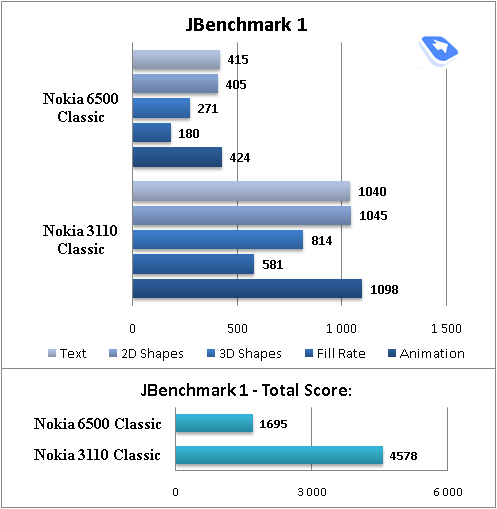
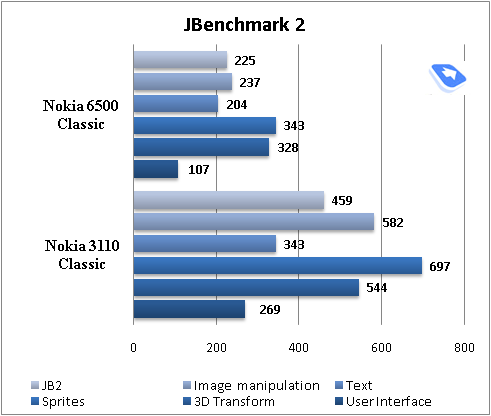
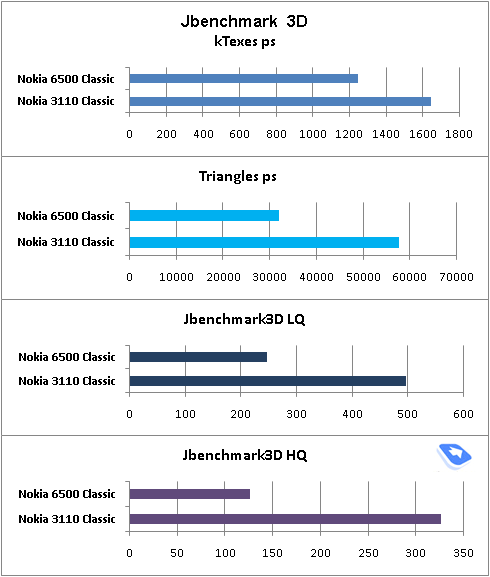
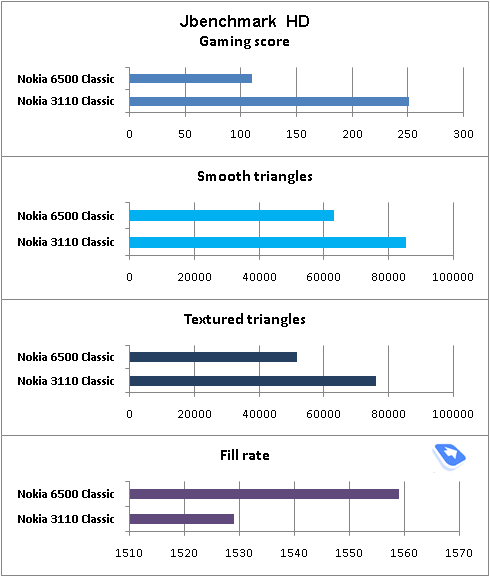
Back to the table of contents >>>
USB, Bluetooth
USB. The handset employs the miniUSB socket mounted on the lower edge of the device. This socket is used for plugging in data cables, which can’t charge the phone, however.
Upon a successful connection you will be able to choose the MPT (the handset’s memory gets identified as a removable store, can be synchronized with Windows Media Player as well) or PC Studio.
Bluetooth. The 3110 Classic supports Bluetooth 2.0 with EDR. The following profiles are enabled:
- Dial-Up Networking Profile
- Generic Access Profile
- Generic Object Exchange Profile
- Object Push Profile
- Handsfree Profile
- Synchronization Profile
- Basic Image Profile
- Basic Print Profile
- File Transfer Profile
- Stereo Advanced Audio Distribution Profile (A2DP)
- Advanced Audio/Video Remote Conference Profile
The phone’s Bluetooth was never an issue – we experienced no difficulties when we tried to synchronized it with a PC or transfer files to other devices. The 3110 Classic also handled stereo-headsets in a convenient fashion.
Back to the table of contents >>>
Camera
The 3110 Classic enjoys a subpar 1,3 Mpix CMOS camera, however for such an unsophisticated model the 3110 Classic is, this module is quite enough. Truth be told, its shots look pretty good for a 1,3 Mpix unit.

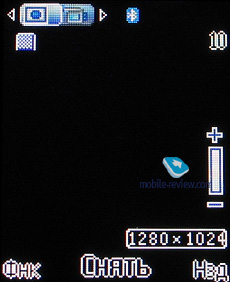
The following image resolutions are supported:
- 1280õ1024
- 1280x960
- 800x600
- 640x480
- 320x240
- 160x120.
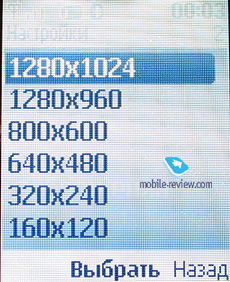
Three quality level are available for JPEG files: basic, normal and high.
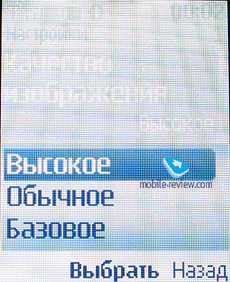
Overlays:
- False colors
- Greyscale
- Sepia
- Negative
- Solarise

White balance:
- Auto
- Daylight
- Tungsten
- Fluorescent

The shutter sound can be disabled, also there is a 8x digital zoom, but there is no reason to use it.
Zoomed image sample:
You can save photos in the internal memory of the phone or on the memory card.
For those who love to shoot a lot of photos at once, there is special mode for you – camera makes up to 3 shots at a time, all settings remain similar to those selected for the single shot mode, including the resolution. There is an auto-timer for self-shots.
Video. The handset allows recording video in 3GP format, available resolution – 128x96 pixels, or 176x144 pixels. There are three recording quality settings available. You can limit a recording’s length, but it also can be unlimited, so you will keep recording until the memory runs out (memory card or internal memory). Effects can be applied for video just as they can be applied for photos, they are all the same.
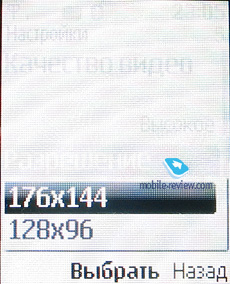
We found the quality offered by the 3110 Classic just fine - its snaps have a fair bit of noises, but when you are in good light and weather conditions, the camera will output pretty good images.
 |
 |
| (+) maximize, 1280x1024, JPEG |
(+) maximize, 1280x1024, JPEG |
 |
 |
| (+) maximize, 1280x1024, JPEG |
(+) maximize, 1280x1024, JPEG |
 |
 |
| (+) maximize, 1280x1024, JPEG |
(+) maximize, 1280x1024, JPEG |
 |
 |
| (+) maximize, 1280x1024, JPEG |
(+) maximize, 1280x1024, JPEG |
 |
 |
| (+) maximize, 1280x1024, JPEG |
(+) maximize, 1280x1024, JPEG |
 |
 |
| (+) maximize, 1280x1024, JPEG |
(+) maximize, 1280x1024, JPEG |
 |
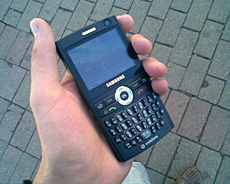 |
| (+) maximize, 1280x1024, JPEG |
(+) maximize, 1280x1024, JPEG |
 |
 |
| (+) maximize, 1280x1024, JPEG |
(+) maximize, 1280x1024, JPEG |
 |
 |
| (+) maximize, 1280x1024, JPEG |
(+) maximize, 1280x1024, JPEG |
 |
 |
| (+) maximize, 1280x1024, JPEG |
(+) maximize, 1280x1024, JPEG |
 |
 |
| (+) maximize, 1024x1280, JPEG |
(+) maximize, 1024x1280, JPEG |
Back to the table of contents >>>
Menu
We won’t be inspecting the handset's core functionality in this particular write-up, since it is a standard S40-based device, so you can learn more about it here.
The Nokia 3110 Classic runs S40 3rd edition Feature Pack 2, so, obviously, it comes included with all updates found in this platform version.

Back to the table of contents >>>
Themes, applications, games
The handset sports two very straightforward themes – blue and white that change colors schemes and wallpapers of certain menus.
Also there is a batch of games, specifically Snake III, Soccer 3D and Sudoku, which is par for the course as far as Nokia is concerned.
The Applications section houses the World Time utility, as well as the second version of Yahoo! Go.
Back to the table of contents >>>
Competition
Price-, form-factor and spec-wise, the Nokia 3110 Classic is struggling against a number of rivals even within its maker's own line-up. Let’s see what its competition really is (all prices are approximate)
- Samsung E200 – 150 USD
- Nokia 3109 Classic – 170 USD
- Nokia 3110 Classic – 210 USD
- Motorola L9 – 210 USD
- Nokia 3500 Classic – 220 USD
- Samsung E590 – 230 USD
For starters, let’s keep this fact in mind – all the models above pack Bluetooth and support for microSD memory cards.
Now for the differences - the Nokia 3110 Classic isn't much different from the 3500 Classic, specifically they are set apart by their camera modules and some design/looks-related things.
Speaking in favor of the Motorola L9 is its much more vibrant display, slimmer profile with metal accents, slightly better camera.
The Samsung E200 stands in one line with the 3110 Classic specs-wise with its 1,3 Mpix camera, radio, but it still comes in with a better display (176x220 pixels against the 3110 Classic's 128x160).
Facing the 3110 Classic off against the Samsung E590 isn‘t a good idea though, since the latter comes for the higher price-bracket, but just for the sake of it we will look into it. Design-wise, these two share some touches – no-nonsense lines, all-black casing, very conventional shape. In terms of technological talents, Samsung's supremacy requires no lab tests: its camera trumps all its rivals (3,2 Mpix with auto-focus), around 70 Mb of built-in memory comes along with the memory expansion slot and it has a decent display. Some value dimensions more than all these figures, and the E590 comes out victorious again - it is even more pocketable than the 3110 Classic.
While the 3110 Classic may look out of order in this array of phones, being the least sophisticated of them, it is not the steepest offering either, and it packs a pretty much conventional feature set for that matter
From our point of view, this phone's major letdown is its hopelessly dated display with a meagre resolution. While consumers tend to shape up their impressions of handsets basing on this detail, Nokia’s mid-to-low range phones feature some very mediocre units. But there is more to the 3109 Classic and the 3110 Classic than that.
Back to the table of contents >>>
Nokia 3109 as a secondary phone
Basically, any phone will do as your secondary phone – be it a feature phone, a smartphone or even a communicator (there are people employing two communicators at a time).
And it greatly depends on each user's preferences - some are looking for a decent camera-phone because their primary device is not good at shooting, some are after music-minded phones, since their primary unit's battery is sucked out by WiFi connections pretty quickly already, and others want to grab hold of a very straightforward handset for calls and the budgets of the latter don't go beyond 70-120 USD.
Thanks to a number of its traits, the Nokia 3110 Classic turns out to be a pretty decent secondary-phone solution. Let’s find out why.
Design. The phone’s looks and dimensions couldn’t be any more conventional – the Nokia 3110 Classic seems to be exactly what it is, also it doesn’t look cheap or luxurious, just a solid, quality thing. People I showed this phone two neither loved it nor hated it, to them it was nothing more but a mobile phone. That’s why design-wise it is a pretty much perfect handset for just about any user, even if your primary unit is, say, the Nokia 8800.
Spec sheet. This handset is not a technological marvel, but it packs all the essentials, even though its display is quite meagre, but it does the job when it comes to calling features.
Ergonomics. The navigation cluster and the numeric keypad are a cinch to handle. Like we already said, texting with them is a breeze even when wearing gloves.
Standby time. One of this handset’s fortes as a secondary phone. If you don’t usually make a ton of calls with your secondary device, then the 3110 Classic can live in your bag without asking for some juice for about a week - its battery level will still be enough to come to your rescue when you will really need it.
Casing. Thanks to its soft-touch finish on most of the casing’s parts, the 3110 Classic is very scratch- and scuff-resistant, although it can't avoid having some, it can surely hide them very well.
Probably, this opinion has been affected by the fact that I used the 3110 Classic as my secondary phone for more than a month - over this time span I came to love it in this capacity.
Back to the table of contents >>>
Impressions
The volume of 64-chord ring tones is far above average - your 3110 Classic won't pass unnoticed in any environment, even in subway. The vibro alert takes a back seat in this case (if you will miss a call probably only while in closed headphones), even though it is quite good. The 3110 Classic delivers good call quality, just like any other latest-gen phone, however it could use some more volume for the earpiece, as in call-unfriendly environments you may well experience some problems.
The model retails for around 210 USD (150 Euro) these days, and looking at the offerings it competes with, the Nokia 3110 Classic is pretty much overpriced even when it has been available for some time. Although, it boasts a number of distinctive touches - no-frills looks, pocketable dimensions and decent ergonomics in particular.
This phone will appeal to those seeking an unsophisticated handset for calls or a secondary device (and having no shortage of money at that). The 3109 and the 3110 Classic are behind Sony Ericsson’s solutions as far as the younger audience is considered (for lacking Java multitasking), and they are not style-conscious devices as opposed to the Motorola L9 and the Samsung E200. But nevertheless, these two are still pretty capable calling, ringing and buzzing devices.
Back to the table of contents >>>
Artem Lutfullin (artem.lutfullin@mobile-review.com)
Translated by Oleg Kononosov (oleg.kononosov@mobile-review.com)
Published — 21 December 2007
Have something to add?! Write us... eldar@mobile-review.com
